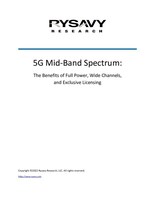WASHINGTON, Nov. 17, 2022 /PRNewswire/ -- Allocating hundreds of megahertz of additional mid-band spectrum for exclusive, licensed commercial use at full power in wide, contiguous spectrum channels is critical to achieving the full benefits of next-generation 5G networks and unlocking innovation, according to a new report from Rysavy Research, commissioned by CTIA.
"In order to unlock the innovations that will define the next decade such as wireless home broadband, industrial IoT, extended reality and the metaverse, it is essential that policymakers prioritize allocating hundreds of megahertz of additional mid-band spectrum with innovation-friendly rules," said Peter Rysavy, President, Rysavy Research. "Exclusive use licenses, full power levels and wide continuous channel sizes enable providers to build highly efficient, cost-effective 5G networks with the speed, latency and security these applications need to transform the way we live and work."
Mid-band delivers the balance of broad geographic coverage and high bandwidth essential to 5G services. The United States currently trails other leading countries who have made an average of 140% more mid-band spectrum available for their 5G networks. Closing this gap is critical to maintaining America's 5G leadership and meet growing demand. According to Rysavy Research, however, to unlock 5G's full potential and enable the industries and innovations of the future, this spectrum must be made available with innovation-friendly rules, including:
- Exclusive licenses which provide wireless operators with the ability to develop highly secure, interference-free networks and deliver a consistent quality of consumer experience. They also provide the certainty operators need to invest tens of billions each year to grow their networks, including a record $35B in 2021 and $121B over the past five years.
- Full power levels which boost capacity, while also requiring fewer cell sites, allowing operators to provide coverage more widely in a cost effective manner. According to Rysavy Research, it would take five times as many cell sites to cover a suburban area and seven times as many to cover to a rural area with low power levels similar to CBRS than it would with high power levels similar to C-band. Requiring more cell sites increases costs and slows deployments.
- Wide bands of contiguous spectrum, which mean providers can achieve high throughput and faster speeds more efficiently than approaches requiring operators to manage networks across narrow, noncontiguous spectrum channels. Wide channels also reduce costs per bit by as much as 70% compared to narrow channels.
The report provides an in-depth analysis of how and why these spectrum characteristics are so important.
"5G networks are rolling out faster than any previous generation of wireless, and with 5G for home broadband bringing real competition to cable and becoming the country's fastest growing home broadband solution, its already having a big impact," said Meredith Attwell Baker, President and CEO, CTIA. "As policymakers develop a new National Spectrum Strategy, it's essential that we build on this early success, and fuel these networks with the exclusive-use, licensed commercial spectrum we need to drive innovation across our economy."
Building robust 5G networks is also essential to keep up with Americans' skyrocketing demands for mobile data. Mobile data consumption has increased by more than 100 times since 2010, and the Ericsson Mobility Report predicts that smartphone usage alone will increase to 52 GB/month in 2027 compared to 15 GB in 2021.
For more information: https://www.ctia.org/news/5g-mid-band-spectrum-the-benefits-of-full-power-wide-channels-and-exclusive-licensing
SOURCE CTIA

WANT YOUR COMPANY'S NEWS FEATURED ON PRNEWSWIRE.COM?
Newsrooms &
Influencers
Digital Media
Outlets
Journalists
Opted In





Share this article